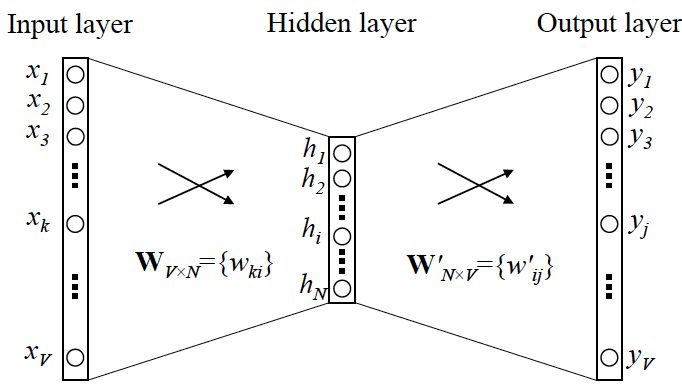1
2
3
4
5
6
7
8
9
10
11
12
13
14
15
16
17
18
19
20
21
22
23
24
25
26
27
28
29
30
31
32
33
34
35
36
37
38
39
40
41
42
43
44
45
46
47
48
49
50
51
52
53
54
55
56
57
58
59
60
61
62
63
64
65
66
67
68
69
70
71
72
73
74
75
76
77
78
79
80
81
82
83
84
85
86
87
88
89
90
91
92
93
94
95
96
97
98
99
100
101
102
103
104
105
106
107
108
109
110
111
112
113
114
115
116
117
118
119
120
121
122
123
124
125
126
127
128
129
130
131
132
133
134
135
136
137
138
139
140
141
142
143
144
145
146
147
148
149
150
151
152
153
154
155
156
157
158
159
160
161
162
163
164
165
166
167
168
| import collections
import math
import os
import random
import zipfile
import numpy as np
import urllib
import tensorflow as tf
import matplotlib.pyplot as plt
from sklearn.manifold import TSNE
def read_data(filename):
"""读取zip的第一个文件并且分割单词为字符串数组"""
with zipfile.ZipFile(filename) as f:
data = tf.compat.as_str(f.read(f.namelist()[0])).split()
return data
words = read_data('text8.zip')
vocabulary_size = 50000
def build_dataset(words):
"""在字典第一个位置插入一项“UNK"代表不能识别的单词,也就是未出现在字典的单词统一用UNK表示"""
count = [['UNK', -1]]
count.extend(collections.Counter(words).most_common(vocabulary_size - 1))
dictionary = dict()
for word, _ in count:
dictionary[word] = len(dictionary)
data = list()
unk_count = 0
for word in words:
if word in dictionary:
index = dictionary[word]
else:
index = 0
unk_count += 1
data.append(index)
count[0][1] = unk_count
reverse_dictionary = dict(zip(dictionary.values(), dictionary.keys()))
return data, count, dictionary, reverse_dictionary
data, count, dictionary, reverse_dictionary = build_dataset(words)
data_index = 0
def generate_batch(batch_size, num_skips, skip_window):
global data_index
assert batch_size % num_skips == 0
assert num_skips <= 2 * skip_window
batch = np.ndarray(shape=(batch_size), dtype=np.int32)
labels = np.ndarray(shape=(batch_size, 1), dtype=np.int32)
span = 2 * skip_window + 1
buffer = collections.deque(maxlen=span)
for _ in range(span):
buffer.append(data[data_index])
data_index = (data_index + 1) % len(data)
for i in range(batch_size // num_skips):
target = skip_window
targets_to_avoid = [ skip_window ]
source_word = buffer[skip_window]
for j in range(num_skips):
while target in targets_to_avoid:
target = random.randint(0, span - 1)
targets_to_avoid.append(target)
batch[i * num_skips + j] = source_word
labels[i * num_skips + j, 0] = buffer[target]
buffer.append(data[data_index])
data_index = (data_index + 1) % len(data)
return batch, labels
batch_size = 128
embedding_size = 128
skip_window = 1
num_skips = 2
valid_size = 16
valid_window = 100
valid_examples = np.random.choice(valid_window, valid_size, replace=False)
num_sampled = 64
graph = tf.Graph()
with graph.as_default():
train_inputs = tf.placeholder(tf.int32, shape=[batch_size])
train_labels = tf.placeholder(tf.int32, shape=[batch_size, 1])
valid_dataset = tf.constant(valid_examples, dtype=tf.int32)
with tf.device('/cpu:0'):
embeddings = tf.Variable(
tf.random_uniform([vocabulary_size, embedding_size], -1.0, 1.0))
emded = tf.nn.embedding_lookup(embeddings, train_inputs)
nce_weights = tf.Variable(
tf.truncated_normal([vocabulary_size, embedding_size],
stddev=1.0 / math.sqrt(embedding_size)))
nce_biases = tf.Variable(tf.zeros([vocabulary_size]))
loss = tf.reduce_mean(
tf.nn.nce_loss(weights = nce_weights,
biases = nce_biases,
labels = train_labels,
inputs = emded,
num_sampled = num_sampled,
num_classes = vocabulary_size ))
optimizer = tf.train.GradientDescentOptimizer(1.0).minimize(loss)
norm = tf.sqrt(tf.reduce_sum(tf.square(embeddings), 1, keep_dims=True))
normalized_embeddings = embeddings / norm
valid_embeddings = tf.nn.embedding_lookup(normalized_embeddings, valid_dataset)
similarity = tf.matmul(valid_embeddings, normalized_embeddings, transpose_b=True)
init = tf.global_variables_initializer()
num_steps = 100001
with tf.Session(graph=graph) as session:
init.run()
print("Initialized")
average_loss = 0
for step in range(num_steps):
batch_inputs, batch_labels = generate_batch(
batch_size, num_skips, skip_window)
feed_dict = {train_inputs : batch_inputs, train_labels : batch_labels}
_, loss_val = session.run([optimizer, loss], feed_dict=feed_dict)
average_loss += loss_val
if step % 2000 == 0:
if step > 0:
average_loss /= 2000
print("Average loss at step", step, ": ", average_loss)
average_loss = 0
if step % 10000 == 0:
sim = similarity.eval()
for i in range(valid_size):
valid_word = reverse_dictionary[valid_examples[i]]
top_k = 8
nearest = (-sim[i, : ]).argsort()[1:top_k+1]
log_str = "与 %s 最接近的词是:" % valid_word
for k in range(top_k):
close_word = reverse_dictionary[nearest[k]]
log_str = "%s %s," % (log_str, close_word)
print(log_str)
final_embeddings = normalized_embeddings.eval()
|

